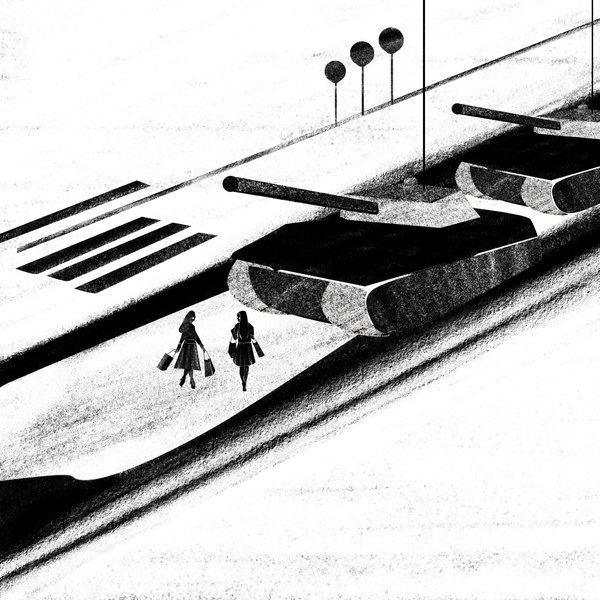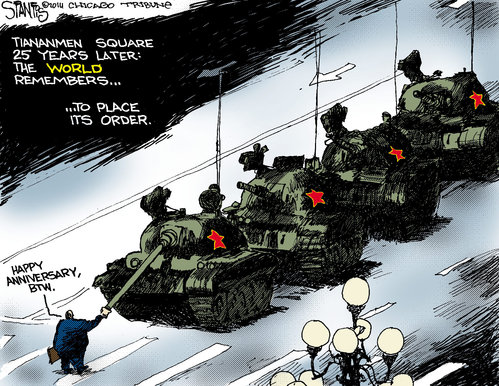Important news sources ranging from the Onion to the New York Times have discussed China’s amnesia regarding the Tiananmen Square massacre that occurred 25 years ago this week. The Times article was accompanied by an illustration that picked up on what has become a common lament: in place of the quashed democratic revolution, China has become a case study in consumer capitalism. Citizens have become shoppers, thronging to the malls instead of the public square.
Needless to say, the point is made visually by invoking the iconic image of a man standing before a row of tanks on Chang’an Avenue. The contrast is clear: by substituting more contemporary figures for the man before the tank, a public act of protest against the authoritarian state has been replaced with political quiescence on behalf of commercial consumption. Nor is the shift in values limited to China.
Whether stylish consumers or fat cat merchants, everyone is on the take. Democracy has been sold out; surely the martyrs did not die for this.
They did not die for China’s mashup of capitalism and authoritarian government, but the story always was more complicated than the ironic contrast would suggest. To see that, you need look no farther than the iconic image.
As John and I argued in No Caption Needed (the book), the Tiananmen tank icon channels a deep tension within Western, liberal-democratic societies: it articulates both democratic and liberal attitudes, reflecting what is a persistent trade-off one way or the other in modern politics. This tension often is resolved very productively, but it is constitutive and dangerous. As Tocqueville, Benjamin Barber, and others have suggested, democracy nurtures liberalism, which ultimately can subvert democracy. Note also that China has expanded private liberties without democratization.
The democratic commitment is to governance of, by, and for the people. The liberal commitment is to respect and protect the autonomy of the individual person. These are not the same thing, and neither is an unalloyed good thing: democracies can become a tyranny of the majority, and individual freedom can be used to harm one’s fellow citizens. More to the point of the Tiananmen commemorations, liberal democracy means that you should be able to elect your public officials, and to ignore politics altogether while you shop until you drop.
In the tank icon, a lone individual stands up the to impersonal state on behalf of the people, and so it is a liberal-deomcratic vision, but more liberal than democratic. Consider, for example, how much is not being shown of the democratic movement that had inhabited the Square for weeks. Consider also that the original protester was holding what appears to be a shopping bag.
The full argument runs to 34 pages, which I’ll leave to your discretion. (Hey, would it kill you to buy the book?) Nor am I suggesting that commemorations of the massacre are misplaced. The people living in Hong Kong will not let us forget, and we shouldn’t. But nor should we get off too easy. Citizens are turned into consumers every day while democratic governance is being subverted on behalf of oligarchy, and I’m not talking about China.
The man standing before the tank embodies two fundamental principles, not one, and the challenge of making them work together is one of the great ongoing tasks of modern societies around the globe. I have no doubt that China needs more democracy, but I would not offer the present mix of populism and neoliberalism that defines politics in the US today as a splendid model to which they should aspire.
One virtue of iconic images is that they can provide models for citizenship. The tank icon does so, but it also says something about the world in which we have to act. And what seems to be an image, may also be a mirror.
Cartoons by Michela Buttignol/New York Times and Scott Stantis/Chicago Tribune.
Cross-posted at BagNewsNotes.


Discussion